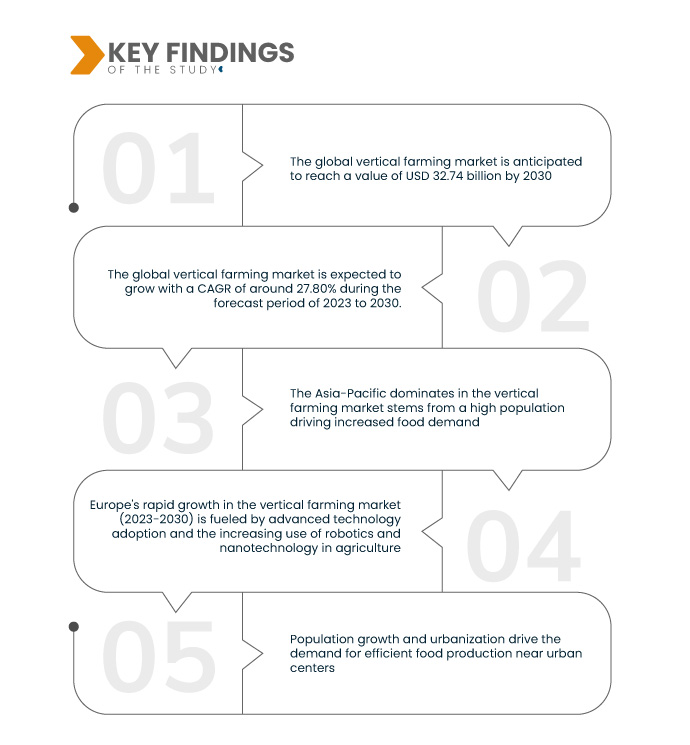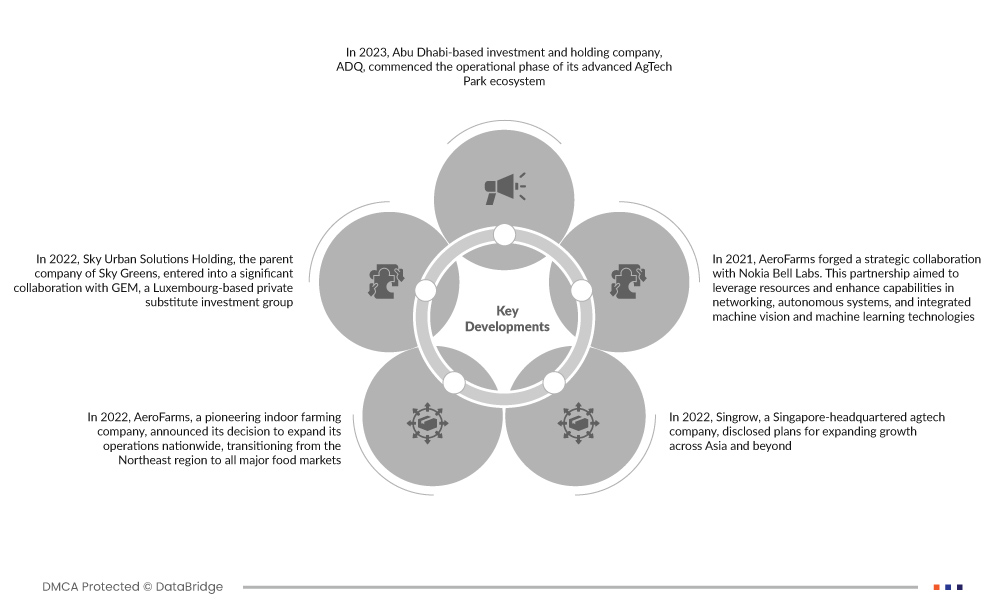Vertical farming's emphasis on resource efficiency is pivotal in addressing critical global challenges. It optimizes water, nutrients, and energy use through precision farming; vertical farming minimizes waste and environmental impact. This is particularly significant in escalating water scarcity concerns, where traditional agriculture often faces inefficiencies. The controlled indoor environment of vertical farms ensures that water is utilized judiciously, reducing overall consumption. Moreover, the precise application of nutrients enhances crop yields while minimizing excess usage.
Access Full Report @ https://www.databridgemarketresearch.com/reports/global-vertical-farming-market
Data Bridge Market Research analyses the Global Vertical Farming Market is expected to reach USD 32.74 billion by 2030, which was USD 4.60 billion in 2022, registering a CAGR of 27.80% during the forecast period of 2023 to 2030. The scarcity of arable land is a key driver for the vertical farming market. Vertical farming's ability to cultivate crops in vertical layers optimizes space usage, addressing the challenge of limited arable land and enabling farming in areas with minimal available space.
Key Findings of the Study
Increasing consumer demand for local and fresh produce is expected to drive the market's growth rate
The increasing consumer demand for local and fresh produce is a significant driver for the vertical farming market. Consumers increasingly prioritize freshness and sustainability, prompting a shift towards locally sourced food. Vertical farming, particularly when strategically located near urban centers, responds to this demand by supplying fresh and high-quality produce. The controlled indoor environment of vertical farms ensures consistent quality year-round. It reduces the need for long-distance transportation, and vertical farming contributes to a lower carbon footprint, aligning with environmentally conscious consumer preferences and driving the market's growth.
Report Scope and Market Segmentation
|
Report Metric
|
Details
|
|
Forecast Period
|
2023-2030
|
|
Base Year
|
2022
|
|
Historic Years
|
2021 (Customizable to 2015-2020)
|
|
Quantitative Units
|
Revenue in USD Billion, Volumes in Units, Pricing in USD
|
|
Segments Covered
|
Growth Mechanism (Hydroponics, Aeroponics, Terraponics, Aquaponics), Structure (Shipping Containers, Building Based), Type (Biopesticides, Biofertilizer, Biostimulants), Crop Type (Leafy Green, Pollinated Plants, Nutraceutical Plant), Application (Indoor, Outdoor), Offering (Hardware, Software Services), Component (Lighting System, Irrigation and Fertigation System, Climate Control, Sensors, Building Material, HVAC Systems, Shelves and Racks, Others), Fruits, Vegetables and Herbs (Bell and Chili peppers, Strawberry, Tomato, Lettuce, Cucumber, Herbs, Leafy Greens (excluding lettuce), Others)
|
|
Countries Covered
|
U.S., Canada and Mexico in North America, Germany, France, U.K., Netherlands, Switzerland, Belgium, Russia, Italy, Spain, Turkey, Rest of Europe in Europe, China, Japan, India, South Korea, Singapore, Malaysia, Australia, Thailand, Indonesia, Philippines, Rest of Asia-Pacific (APAC) in the Asia-Pacific (APAC), Saudi Arabia, U.A.E, Israel, Egypt, South Africa, Rest of Middle East and Africa (MEA) as a part of Middle East and Africa (MEA), Brazil, Argentina and Rest of South America as part of South America
|
|
Market Players Covered
|
Deere and Company (U.S.), CropMetrics LLC (Netherlands), Trimble Navigation Limited (Australia), CropX (U.S.), AgSmarts Inc (India), AgSense, LLC (India), AGCO Corporation (Austria), DICKEY-john (U.K), Monsanto Company (Mexico), Ag Leader Technology (U.S.) Farmers Edge (U.S.), GEOSYS (U.S.), Granular (U.S.), Gro Intelligence (U.S.), Proagrica (U.K.), Fasal (India), AGEYE Technologies (U.S.), HelioPas AI (Germany), OneSoil (Belarus)
|
|
Data Points Covered in the Report
|
In addition to the insights on market scenarios such as market value, growth rate, segmentation, geographical coverage, and major players, the market reports curated by the Data Bridge Market Research also include in-depth expert analysis, geographically represented company-wise production and capacity, network layouts of distributors and partners, detailed and updated price trend analysis and deficit analysis of supply chain and demand.
|
Segment Analysis:
The global vertical farming market is segmented on the basis of growth mechanism, structure, type, application, offering, component, and fruits, vegetables and herbs.
- On the basis of growth mechanism, the global vertical farming market is segmented into hydroponics, aeroponics, terraponics, and aquaponics
- On the basis of structure, the global vertical farming market is segmented into shipping containers, and building based
- On the basis of type, the global vertical farming market is segmented into biopesticides, biofertilizer, and biostimulants
- On the basis of crop type, the global vertical farming market is segmented into leafy green, pollinated plants, and nutraceutical plant
- On the basis of application, the global vertical farming market is segmented into indoor, and outdoor
- On the basis of offering, the global vertical farming market is segmented into hardware, and software services
- On the basis of component, the global vertical farming market is segmented into lighting system, irrigation and fertigation system, climate control, sensors, building material, hvac systems, shelves and racks, and others
- On the basis of fruits, vegetables and herbs, the global vertical farming market is segmented into bell and chili peppers, strawberry, tomato, lettuce, cucumber, herbs, leafy greens (excluding lettuce), and others
Major Players
Data Bridge Market Research recognizes the following companies as the major global vertical farming market players in global vertical farming market are Deere and Company (U.S.), CropMetrics LLC (Netherlands), Trimble Navigation Limited (Australia), CropX (U.S.), AgSmarts Inc (India), AgSense, LLC (India), AGCO Corporation (Austria), DICKEY-john (U.K), Monsanto Company (Mexico)
Market Developments
- In 2023, Abu Dhabi-based investment and holding company, ADQ, commenced the operational phase of its advanced AgTech Park ecosystem. This initiative marked its foray into cutting-edge agricultural technology. In collaboration with the Italian technology company ZERO, ADQ launched a vertical farming project to enhance indoor farming capabilities locally. Moreover, the project sought to push the boundaries of farming in the challenging desert climate of the United Arab Emirates (UAE)
- In 2022, Sky Urban Solutions Holding, the parent company of Sky Greens, entered into a significant collaboration with GEM, a Luxembourg-based private substitute investment group. The agreement provided Sky Urban a shared membership capacity of up to USD 50 million over 36 months. This financial support was intended to bolster Sky Urban Solutions' endeavors, particularly in the realm of sustainable urban farming
- In 2022, AeroFarms, a pioneering indoor farming company, announced its decision to expand its operations nationwide, transitioning from the Northeast region to all major food markets. This strategic move was prompted by the increasing demand for AeroFarms' specialty greens. Notably, AeroFarms positioned itself as the primary indoor farming company in the Whole Foods Market Global Planogram, solidifying its presence in mainstream grocery retail
- In 2022, Singrow, a Singapore-headquartered agtech company, disclosed plans for expanding growth across Asia and beyond. Alongside this expansion, Singrow introduced its consumer concept brand, Blooom. The company aimed to broaden its partner farm footprint, targeting countries such as the Philippines, Hong Kong, Thailand, and the Middle East. This expansion was in addition to Singrow's existing presence in Indonesia, China, and Singapore
- In 2021, AeroFarms forged a strategic collaboration with Nokia Bell Labs. This partnership aimed to leverage resources and enhance capabilities in networking, autonomous systems, and integrated machine vision and machine learning technologies. The joint efforts were geared towards achieving advanced levels of identification and tracking of plant interactions. This collaboration underscored the intersection of agriculture and cutting-edge technologies, with the potential to revolutionize the field of indoor farming
Regional Analysis
Geographically, the countries covered in the global vertical farming market report are U.S., Canada and Mexico in North America, Germany, France, U.K., Netherlands, Switzerland, Belgium, Russia, Italy, Spain, Turkey, Rest of Europe in Europe, China, Japan, India, South Korea, Singapore, Malaysia, Australia, Thailand, Indonesia, Philippines, Rest of Asia-Pacific (APAC) in the Asia-Pacific (APAC), Saudi Arabia, U.A.E, Israel, Egypt, South Africa, Rest of Middle East and Africa (MEA) as a part of Middle East and Africa (MEA), Brazil, Argentina and Rest of South America as part of South America.
As per Data Bridge Market Research analysis:
Asia-Pacific is the dominant region in the global vertical farming market during the forecast period 2023-2030
The Asia-Pacific dominates the vertical farming market due to its burgeoning population and escalating food demand. The availability of a skilled workforce at reasonable wages, vast farmland areas, and concerns over land scarcity further propel the growth of vertical farming in the region. Adopting advanced technologies, particularly in countries with a strong focus on innovation, plays a pivotal role. Moreover, environmental sustainability concerns have heightened the appeal of vertical farming, offering a solution that addresses resource efficiency and reduced environmental impact. In essence, the convergence of these factors positions vertical farming as a crucial and innovative approach to meet the evolving agricultural needs of densely populated urban areas in the Asia-Pacific region.
Europe is estimated to be the fastest-growing region in the global vertical farming market for the forecast period 2023-2030
Europe is expected to experience the fastest growth in the vertical farming market from 2023 to 2030, primarily driven by advanced technological developments and the increasing adoption of robotics and nanotechnology in agriculture. The region's commitment to innovation, coupled with a proactive approach to sustainable practices, has propelled the integration of cutting-edge technologies in vertical farming, enhancing efficiency and productivity. The adoption of robotics streamlines farming tasks, while nanotechnology contributes to improved crop yields and resource utilization.
For more detailed information about the global vertical farming market report, click here – https://www.databridgemarketresearch.com/reports/global-vertical-farming-market












